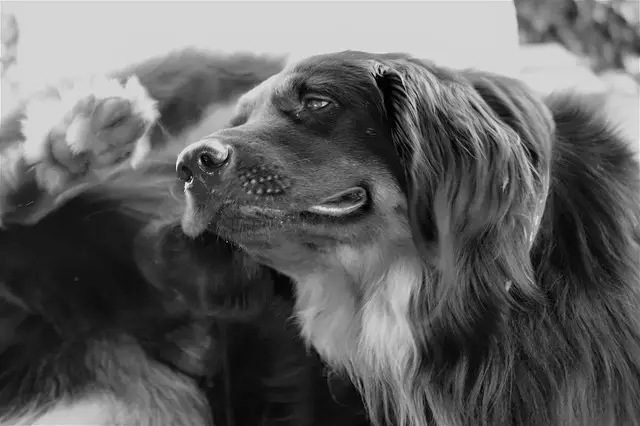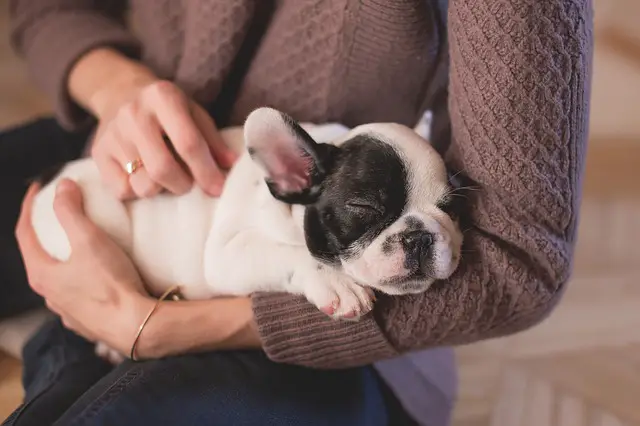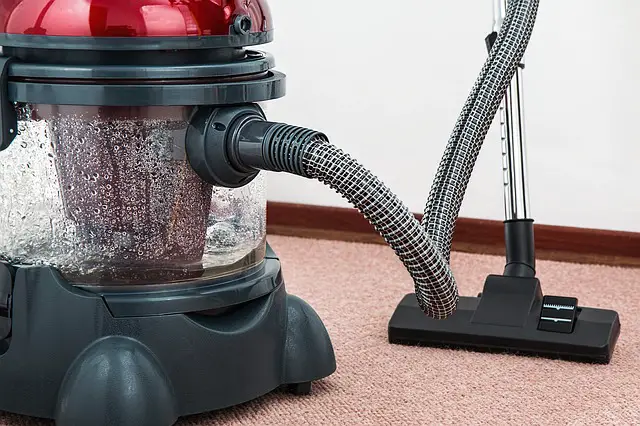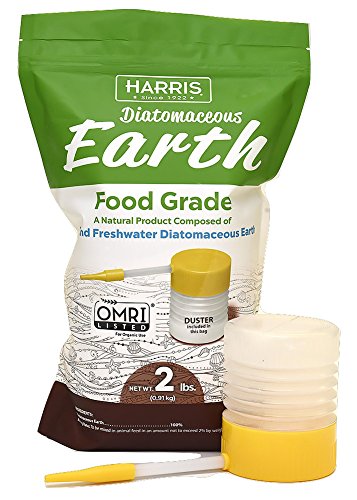
“What do I do if my dog has fleas?” This is a desperate cry for help that becomes more popular among dog parents as the summer months approach and the fleas swoop down. Generally, fleas prefer warmer temperatures of between 65 to 80 degrees as well as high humidity levels of between 75 – 85%. Hence, in some parts of the country (especially the southern part of the United States) where it’s always warm, fleas are more than a summer problem and bother pets all year round.
These blood-sucking parasites are a big problem especially because you don’t even know when the infestation begins. You just wake up one day and realize it.
Oftentimes, flea infestation in dogs occurs from direct contact with other dogs with flea infestation. Also, dogs can pick up fleas from his surrounding as well.
Interestingly, fleas cannot fly as they do not have wings. So, how do they move? Fleas have strong hind legs. With these legs, they jump from one host to another or from a host to the surrounding.
Generally, flea bites simply cause itching in the host. However, if your dog is allergic or sensitive to fleas, itching can become quite severe which can cause extreme scratching and chewing.
If your dog is scratching and chewing excessively, it could cause inflammation, hair loss, as well as secondary skin infections. In fact, for some dogs, the sensitivity to fleas’ saliva is so severe that all that’s needed is a single bite to cause severe itching.
But back to your question “what do I do if my dog has fleas?” We get to that in a minute but before that, a more important step would be to confirm that all that scratching is actually a flea infestation.
Table of Contents
Spotting Fleas On Dogs

Now, it’s very important to first confirm that the reason your dog is having those itches is because of fleas. Sometimes, itching might be as a result of an ear infection, ear mites, a food allergy, or some other irritation.
So, how do you confirm that your dog actually has flea infestation?
The best place to spot fleas on your dog’s body is in the furriest parts around the belly and the inner thighs. This is because fleas do not like light and so they look for the furthest places from the light to hide.
The good thing about fleas is that they are easy to see with your physical eyes unlike other similar parasites like mites.
In morphology (physical characteristics), fleas are really tiny, about half the size of an apple seed or the head of a pin. Sometimes, though, they grow as big as a grain of rice. Their bodies are also laterally flat, and as we said, wingless.
Now, sometimes, you might look thoroughly and still not find actual fleas on your dog. In that case, you might still want to look out for flea dirt. Flea dirt resembles specs of pepper scattered on the surface of your dog’s skin. These dark-colored specks are actually flea poop and are composed mainly of digested blood.
To confirm that this is flea dirt, pick up the specks and put them on a wet paper towel. After a few minutes, these specks are supposed to breakdown and spread out like a bloodstain. If they don’t, your dog might be flea-free. However, if they do, then your dog definitely has fleas.
For a more comprehensive, visual demonstration of how to spot fleas on dogs and pets in general, check out the video below:
What Do I Do If My Dog Has Fleas? — Two Steps To Get Rid Of Fleas On Your Dog
There are two steps to taking care of fleas on dogs.
- First, you have to treat your dog.
- Second, you have to treat your environment.
What Do I Do If My Dog Has Fleas — Treating Your Dog With Fleas
There are a number of ways you can treat flea infestation in dogs. Here are three ways.
1. Oral And Topical Flea Control
Fleas can be very persistent which makes them annoying to treat. However, most flea pills are great at treating fleas on dogs. Plus, they are super fast too.
Now, there are different types of flea control drugs with different forms of fleas that they target. Some only target the adults, others only target the eggs, and yet others only target larvae and adult fleas. So, it’s not just about buying a good flea treatment, it’s about buying the right one.
Also, in some cases, flea control will also come with a heartworm preventative as one treatment. Some will require a vet’s prescription while others will not. So, it’s a wide variety out there.
The best flea treatment for your dog, therefore, will depend on your dog’s individual predicament. So, the best thing to do when you confirm a flea infestation on your dog, is to speak with your vet first.
2. Prescription Flea Medications
Prescription flea control products are a new introduction to the flea control market. It’s amazing how these medications have really improved how we treat flea infestation in dogs especially when you get one from a good brand.
Because these are prescription pills, you must speak to your vet first before heading out to buy one. It’s one of the best and fastest ways to completely rid your dog’s body of fleas.
Like non-prescription flea control drugs, these drugs also have their individual mechanism of action.
Some go for the eggs rather than the adult flea, keeping them from hatching. This, therefore, breaks the life cycle of the flea. Eventually, because there is no reproduction and then the population of the flea would dissipate, provided your dog does not come in contact with fleas continuously afterward.
Generally, flea treatment should begin from early spring going into flea season. However, if you live in an area with a warmer climate, then you might want to make flea treatment all-year round.
Now, if your dog is sensitive to flea saliva, you want to go for a product that targets adult fleas as well as the eggs. This way, if they die off, they are no longer able to bite your pet causing excessive itching.
For those whose hypersensitivity is to the fleas themselves, then choose a product with a flea repellent so that the fleas never get to bite in the first place.
Some examples of prescription flea control are Bravecto (fluralaner) and Comfortis and Trifexis (contains spinosad).
Bravecto works relatively fast, and in 2 hours, begins to kill fleas. This killing action continues to last up until three months after administration.
Spinosad, on the other hand, works much faster, however, does not last as long. In about 30 minutes, it begins to kill fleas but would only carry on for one month after that.
3. Non-Prescription Medication For Flea Treatment
Besides the two treatment options which we already discussed, there are other non-prescription methods which you can use to treat fleas in dogs. However, the problem is they are not as effective as prescription products.
Non-prescription flea treatment products include flea powders, flea shampoos, spot-on products, flea sprays, and flea collars. From what the vets say, many dog parents still have complaints of their dog itching even after using these over-the-counter drugs. In the same vein, we would be dishonest if we said that there weren’t dog parents who did not see good results after using these products.
For instance, there is Capstar which is used to treat flea infestations. It begins to kill adult fleas within 30 minutes after it is taken. It does a great job and kills over 90% of fleas in 4 hours.
You can also get dog flea shampoos which have proven to be quite effective in the treatment of flea infestation.
Generally, working with dog flea shampoos is quite easy. Simply, bathe the dog in the shampoo and you should have the fleas killed at the end of the bath.
Now, you need to be really careful as there are some dogs that don’t like to get soaking wet for a long time at a time. But these dog flea shampoos require up to 5 to 10 minutes for the shampoo to completely sink in and do its work.
Once the bath is done, all the fleas have been killed as you’ve said. Comb your dog’s fur with a comb afterward to take out the dead fleas.
Nevertheless, do keep in mind that flea shampoos do not protect your dog from a reinfestation.
Please note that you can’t use tea tree oil as flea repellent as it is toxic to dog. Click here to read our article on 197 foods dogs can’t eat to find out other foods and materials that are toxic to dogs).
What Do I Do If My Dog Has Fleas? — Treating Fleas In Your Environment
It’s not enough to treat the flea infestation in your dog, you’d also have to treat your environment as well. Also, it’s not enough to just sprinkle some flea powder on your carpet, vacuum vigorously, deck your dog in a flea collar and then go to sleep. All these won’t work.
You must do a more thorough job and it begins with understanding the life cycle of a flea.
The Life Cycle Of A Flea

The reason understanding the life cycle of a flea is important to treating flea is because treatment procedures work differently. That is, there are treatments that are targeted at the different parts of the flea life cycle.
So, let’s see what this life cycle looks like.
The cycle begins with the egg, goes on to the larva, then to the pupa or the cocoon, and then to the mature adult. How long this process takes would depend on a number of factors. Some of them include humidity, temperature, and the availability of a host. Generally though, that time could fall anything between two weeks to one year.
The host of a flea must be warm-blooded and can be an animal like a cat or a dog but can also be a human. Fleas, though, are quite resistant to freezing temperatures at the different stages of their life.
From The Egg To The Adult
So, beginning with the adult female flea. It lives on its host for several days, sometimes, up to weeks. Within this period, she will receive nourishment from her host by sucking the animal’s blood about twice or thrice daily. She will also lay about 20 to 30 eggs daily which can add up to hundreds of eggs over the course of her lifetime.
These eggs are laid on the skin of the animal. However, from here, it falls into the dog’s surrounding on the bedding, the yard, the carpet, and anywhere the dog finds himself.
Wherever they are, these eggs then hatch into the larval stage.
Because eggs are already about half the size of an adult flea, they don’t have a problem finding a place to grow. They can grow just about anywhere including cracks and crevices. In such places, they will feed on any organic matter within reach, dead skin scales, or even the adult flea feces which we have seen to contain blood.
As larvae, fleas molt twice and then form a cocoon (like a butterfly) and pupate. In this stage, they wait until the time is right before maturing into full-grown adults. As pupae, fleas are quite resilient and can survive for a very long time inside their cocoons which protect them.
However, once a host is made available and the conditions are just right, they then emerge from these cocoons. But how do they know when the conditions are right? Pupae are able to detect signals of the availability of a host in forms of heat, vibrations, as well as carbon dioxide. These tell the pupae that a host is now available, they then emerge from their cocoons as adult fleas and jump with their powerful hind legs onto a host.
If the conditions are optimal, it could take 14 days for a flea to complete its entire life cycle. So, it takes only a little time for your home to be infested by thousands of crawling imps as long as the conditions are great.
How To Treat Fleas In Your Environment
Now, when you treat fleas in your environment, you must, of necessity, treat all animals in the house. You’d also have to treat your home both indoors and outdoors.
In this video, we see a step-by-step visual demonstration on how to thoroughly and completely eliminate fleas from your home, both indoors and outdoors.
Treating Flea Indoors
Here’s how you do this.
First, you have to wash all the bedding in the house in hot, soapy water.
Also, you must vacuum all carpeting thoroughly and then throw the vacuum bag away, or empty the canister, or throw the trash outside. You can also steam clean your carpets as well to kill off some of the larvae left.

Now, keep in mind that vacuuming, shampooing, steam cleaning, all these are not enough to get rid of the fleas 100%. You’d still have to use some chemical treatment as well to completely eradicate the fleas.
After doing all of that, you’ve then set the stage for the actual treatment of fleas. There are a number of options you can try at this stage.
If you have a home where there are small kids, you might want to use boric-acid based products instead. They are effective but they are also a much safer option because they do not leave any chemical residue which your children might interact with.
The most effective method of treating of fleas completely indoors is with an insect growth regulator. They are great because they not only kill the adult fleas, they also contain an ingredient that kills the fleas at other stages of the life cycle.
An example of an insect growth regulator is methoprene. While foggers are generally highly effective, aerosol foggers tend not to penetrate easily enough to kill hidden adult fleas as well as larvae.
Another option for indoor flea treatment is sodium borate products.
Finally, if you think this is beyond you, it is not a bad idea to get a local exterminator to get rid of the flea infestation in your premises. It sure isn’t cheap, but it will sure give you peace of mind.
Treating Fleas Outdoors
When it comes to outdoor flea control, the first thing to do is to clean your dog’s house and his kennels thoroughly. Afterward, most use insecticides in the form of sprays or pellets but you can also use an insect growth regulator as well.
If you decide to use an insect growth regulator, you might want to go for Pyriproxifen seeing as it is more stable in sunlight and lasts longer outdoors.
Another option you could use in treating flea infestation outdoors is diatomaceous earth. Diatomaceous earth is effective but it is also non-toxic so it’s safe to use in the children’s play-area and around your vegetable garden. In choosing diatomaceous earth products, you want to go for products that are categorized as food-grade as they are safer around pets.
Finally, there’s also the option of using non-toxic nematodes as well. Normally, you’d spread these nematodes in the warm, moist part of your yard. These nematodes feed on the larvae of the flee, and then come winter, when snow begins to fall, the source of the flea would have been eliminated, at least for the most part.
In summary, “what do I do when my dog has fleas?” consult with your vet first before you begin any treatment procedure for your pets. They are in the best position to give you the best information for treating flea infestation both on your dog and in your environment.
(Click here to read our article on dog flea and tick control).




